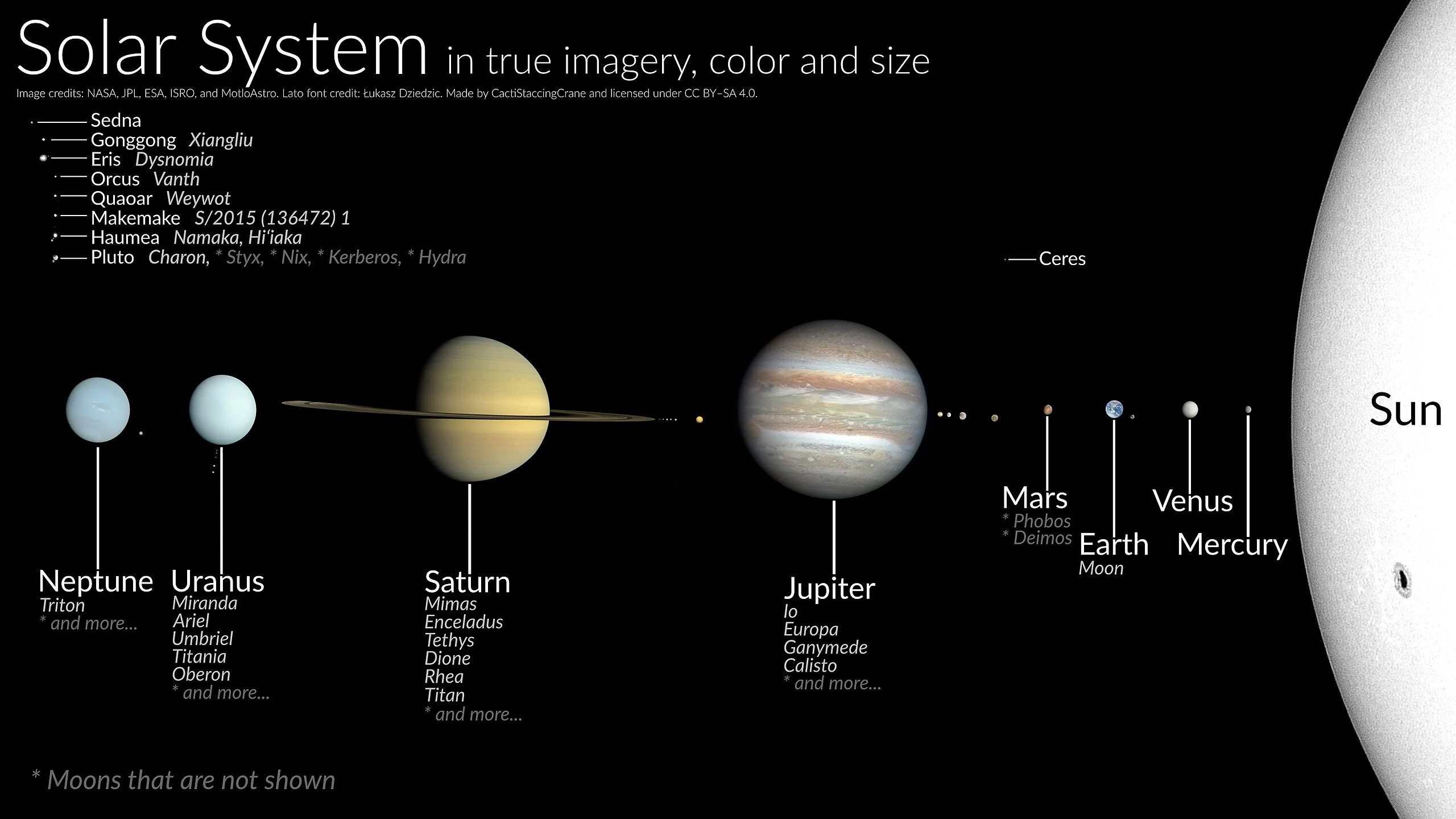
Hi, and welcome to this overview of the solar system! Today, we’re going to take a look at what components make up our solar system, and discuss the prevailing theories as to how and when our solar system came to be. Let’s get started!
To begin, let’s clarify a couple of terms and what they mean, starting with the Sun. The ball of light that you and I call “the Sun” actually has an official name, which is Sol. The name comes from the Latin word for Sun, solis. Our word solar comes directly from the name Sol, so solar panels, solar eclipses, and solar flares are all related to our sun, Sol. Now let’s think about the term solar system. A solar system isn’t a system that’s connected to any old sun in the sky; a solar system is literally “the system of Sol.” This means that ours is the only system in all of space that can be called a solar system.
The generic term for our solar system is planetary system, and there are 3,200 other planetary systems within the Milky Way galaxy.
Solar System Criteria
So, what is a planetary system? To be called a planetary system, there are three main criteria that have to be met.
- The system contains a central body that is a star
- There are one or more planets orbiting the star
- The system is in a relatively flat region in space
A star is a spherical object composed of gas that contains enough heat and pressure in its core to maintain nuclear fusion. The star in a planetary system has enough gravitational force to keep all the planets inside this system. The planets orbit the star in a relatively flat plane, in elliptical paths.
In order to understand the solar system and how it evolved, we have to look at its main components. By observing these bodies and their dynamics, it is possible to piece together a theory of how they began. Let’s start with planets.
The Planets
According to the International Astronomical Union, there are three criteria that need to be met for something to be called a planet.
- It must have enough gravitational force to condense its mass into a spherical shape
- It must have a greater gravitational force than the objects close to it
- It must have cleared the neighborhood around its orbit
The solar system has eight planets, but for almost 80 years, it was considered to have nine. This ninth planet was discovered in 1930 and given the name Pluto.
It held its planetary status until 2006, when the IAU updated their criteria detailing what a planet is and demoted Pluto to dwarf planet status.
One of the IAU’s secondary criteria for being a planet is that the planet must not be a satellite or orbit any body other than a star. Pluto’s largest moon, Charon, is very massive and about half as large as Pluto. This means that Pluto and Charon are both orbiting about each other as a binary system, not a planet-moon system.
Pluto is also composed of solid material, which is in contrast to the four gas giants that are closest to it. Furthermore, Pluto’s orbit is almost 17 degrees off the plane within which the other planets in our solar system orbit.
These observations of Pluto suggest it was not originally part of the solar system. Objects formed during the creation of our solar system should have material that is differentiated according to distance from the Sun (the solid materials nearest the Sun, lighter gases farther away). They should also orbit in nearly the same plane.
As viewed from above the north pole of the Sun, all the planets in the solar system orbit the Sun in a counterclockwise motion. Almost all of the planets also rotate about their axes in the same counterclockwise fashion, as viewed from above their north poles.
There are two exceptions: Uranus and Venus.
The rotational axis of Uranus is tilted almost 98 degrees from the orbital plane, making it almost exactly perpendicular to its orbit about the Sun. One theory is that an Earth-sized object collided with it, shifting its axis.,
Venus undergoes an extremely slow retrograde rotation. A small group of astronomers now believe that Venus was originally rotating in the same direction it orbits the Sun, but somehow its axis flipped over, giving it the appearance of being in a retrograde orbit. Another hypothesis is that the planet’s rotation slowed down and somehow reversed itself due to the friction of its atmosphere.
Moons, Asteroids, and Beyond
Now, planets aren’t the only things floating around in planetary systems. As I’m sure you’re aware, some planets are accompanied by moons. A moon is simply a natural satellite that orbits a planet, dwarf planet, or asteroid. We’ll talk more about asteroids later.
Our solar system contains hundreds of moons, with more moons being discovered all the time. The planet with the most moons is Saturn, which is being orbited by 79 moons. Earth is the only planet in our solar system with a single moon, and Mercury and Venus are the only planets that have no moon at all.
Most all of the moons orbiting planets in our solar system have a prograde orbit about their planets. This means they are orbiting their planet in the same direction as the planet’s rotation. The exception to this is Neptune’s largest moon Triton.
Generally smaller than moons, asteroids are another common artifact in our solar system.
Between Mars and Jupiter is an asteroid belt, which is where the majority of known asteroids orbit. The belt is estimated to contain 1-2 million asteroids larger than half a mile in diameter, and millions of smaller ones.
Early in the solar system’s formation, the gravity of newly formed Jupiter brought an end to the formation of planetary bodies in this region, which caused small planetary bodies to collide with one another and fragment into the asteroids we see today.
So, how long has our solar system been around? The age of the solar system is estimated by using a number of different techniques and then comparing results. It’s assumed that the solar system formed as one entity, so the Sun and planets formed around the same time.
Measuring the age of rocks is one of the techniques used. The oldest rocks on Earth have been dated to be approximately 4.6 billion years old by measuring radioactive isotopes. Meteorites from the solar system have been radioactively dated to be around the same age.
The oldest fossils on Earth are estimated to be about 3.5 billion years old, showing that the Earth would have been habitable for life then. Since these organisms needed light, the Sun must have formed by this time.

Nebular Hypothesis
The Nebular Hypothesis is the prevailing theory of how our solar system began. This theory assumes the solar system began as a large cloud of dust and gas. This giant cloud began to condense under its own gravity, spinning as it did so. Perhaps initiated by an external event, this rotational motion caused the particles of dust to acquire an angular momentum and rotational inertia. These two physical actions caused two things to happen:
- The cloud condensed so much, that at its center, the mass became concentrated with enough pressure and temperature to ignite nuclear fusion reactions, creating the Sun.
- While this cloud condensed, the rest of the mass began to flatten out due to the cloud’s distribution of angular momentum.
Given that the cloud’s mass was not uniformly dense, clumps of mass began to accumulate at various locations on the disc. This was caused by both collisions of particles and the greater gravitational forces of the larger clumps of mass. These clumps then developed into planets.
The larger gas planets, from Jupiter outward to Neptune, are believed to have been mini-planetary systems that didn’t have enough mass to ignite a star in their centers. All of these Jovian planets have rings—or planes within which their satellites orbit.
The Nebular Hypothesis is supported by several observations of our solar system:
- all the planets orbit the Sun in roughly the same plane;
- all the planets orbit the Sun in the same direction the Sun spins on its axis;
- most of the planets rotate in the same direction as they orbit the Sun;
- almost all of the moons of planets orbit them in the same direction they spin;
- and radioactive dating of meteorites and rocks agrees with the idea that most objects in our solar system formed around the same time.
These observations are consistent with the idea that the solar system flattened into a disc, and that all the planets are moving in the same direction of rotation within this disc.
Of course, there are still mysteries with this theory due to observations that do not support the theory. First, Venus and Uranus experience retrograde rotation. Secondly, Triton, a moon of Neptune, has a retrograde orbit. Thirdly, our discovery of many other planetary systems indicates there are giant planets, like the Jovian planets in our planetary system, orbiting very close to their star.
In the last few decades, our understanding of our own planetary system has been aided by finding and studying other planetary systems throughout the cosmos. The answer to how our solar system formed is not an indisputable fact, but an ongoing inquiry.
Now, before we go, let’s look over a few review questions.
Review Questions
1. How many solar systems are there in the Milky Way galaxy?
- 3,200
- 8
- 1
- 80
2. The asteroid belt is found between which two planets?
- Mars and Jupiter
- Earth and Neptune
- Mars and Neptune
- Earth and Jupiter
3. Which of the following is NOT a part of modern theory?
- The solar system is roughly 4.6 billion years old
- The solar system began as a large cloud of dust and gas
- The large gas planets are believed to have been potential mini-planetary systems
- The solar system formed from tidal interactions between the Sun and a low-density protostar.
That’s all for this review! Thanks for watching, and happy studying!
- “How Many Solar Systems Are in Our Galaxy? | NASA Space Place – NASA Science for Kids.” n.d.
- “Pluto, Dwarf Planet.” n.d.
- NASA. 2018. “In Depth | Uranus – Solar System Exploration: NASA Science.” Solar System Exploration: NASA Science
- da, Shigeru, Shoji Ueta, Takanori Sasaki, and Yuya Ishizawa. 2020. “Uranian Satellite Formation by Evolution of a Water Vapour Disk Generated by a Giant Impact.” Nature Astronomy
- “Planet.” n.d.
- “In Depth | Asteroids – Solar System Exploration: NASA Science.” Solar System Exploration: NASA Science

